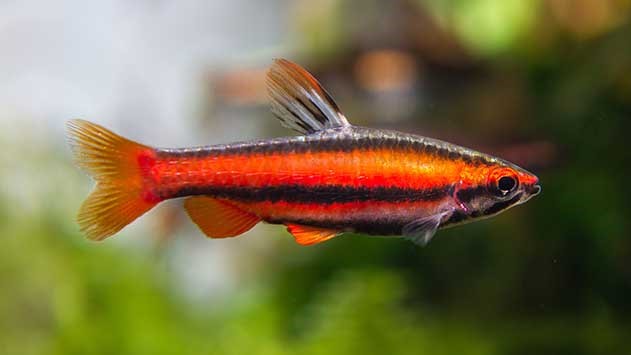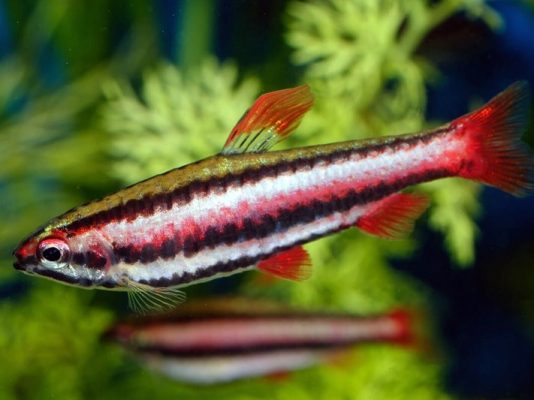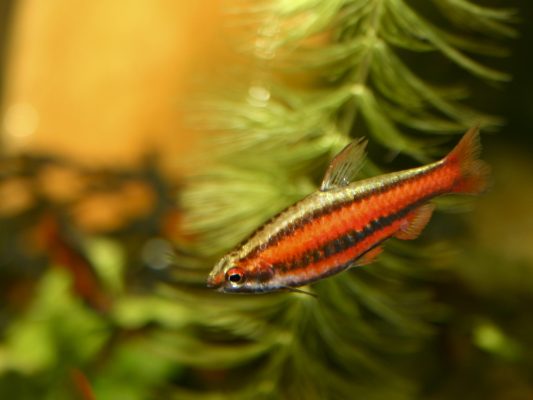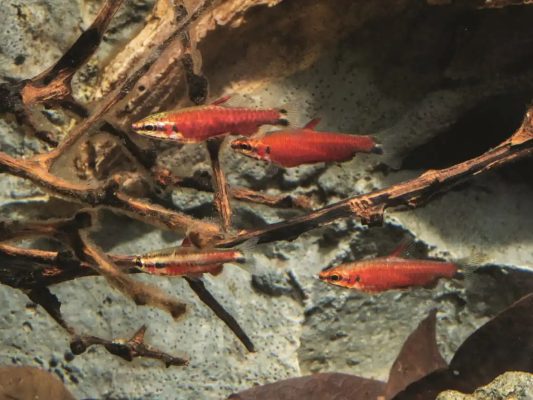Coral-Red Pencilfish

Table of Contents
- Introduction
- Taxonomy and Classification
- Habitat and Distribution
- Behavior and Adaptations
- Reproduction and Breeding
- Conservation Status and Threats
- Conclusion
Introduction
The coral-red pencilfish, scientifically known as Nannostomus mortenthaleri, is a captivating and highly sought-after species among aquarium enthusiasts. Its vibrant coral-red coloration, complemented by contrasting black stripes, makes it a visually striking addition to any aquarium. This species is also commonly referred to as N. mortenthaleri, named after the renowned German ichthyologist, Uwe Römer Mortenthaler.
Studying the coral-red pencilfish is of great significance to both aquarium hobbyists and researchers. For aquarium enthusiasts, this species offers a unique and visually appealing option for their tanks. Understanding the coral-red pencilfish’s behavior and adaptation can aid in creating optimal conditions for their well-being in captivity.
From a scientific perspective, delving into the intricacies of this species can provide valuable insights into fish behavior and adaptation. The coral-red pencilfish’s vibrant coloration and social behavior make it an ideal subject for studying the evolution of visual signals and social hierarchies among fish species.
In this article, we will explore the various aspects of the coral-red pencilfish, shedding light on its unique features and ecological importance. By delving into its taxonomy, physical characteristics, habitat, behavior, breeding habits, and conservation status, we hope to provide readers with a comprehensive understanding of this captivating species.
Taxonomy and Classification
Scientific classification of the coral-red pencilfish
The coral-red pencilfish, scientifically known as Nannostomus mortenthaleri, belongs to the family Lebiasinidae and the order Characiformes. Its taxonomic classification is as follows:
- Kingdom: Animalia
- Phylum: Chordata
- Class: Actinopterygii
- Order: Characiformes
- Family: Lebiasinidae
- Genus: Nannostomus
- Species: mortenthaleri
Description of its physical characteristics, including size, coloration, and unique features
The coral-red pencilfish is a visually striking species with unique physical characteristics. On average, it reaches a size of around 2-2.5 inches (5-6 centimeters) in length. Its elongated body shape and streamlined fins contribute to its graceful appearance.
One of the most distinctive features of the coral-red pencilfish is its vibrant coral-red coloration. The entire body of the fish is adorned with this mesmerizing hue, which is further accentuated by contrasting black stripes that run horizontally along its body. These stripes create a visually appealing pattern and add to the overall allure of the fish.
In addition to its coloration, the coral-red pencilfish possesses other unique features. It has a slender body, which allows it to navigate through dense vegetation in its natural habitat. The fins of the fish are well-developed and provide the necessary propulsion for its swift movements.
Comparison with other pencilfish species
When comparing the coral-red pencilfish with other species of pencilfish, several distinguishing characteristics and behaviors become evident.
Firstly, the coral-red pencilfish stands out due to its vibrant coral-red coloration. This sets it apart from other pencilfish species that may exhibit different color variations, such as yellow or silver.
In terms of behavior, the coral-red pencilfish is known for its peaceful and shoaling nature. It thrives when kept in groups, displaying a social hierarchy within the group. This behavior is in contrast to some other pencilfish species that may exhibit more solitary tendencies.
Furthermore, the coral-red pencilfish showcases unique adaptations for survival. Its ability to camouflage in its natural habitat, blending in with the surrounding vegetation, is a notable adaptation. This differs from other pencilfish species that may rely on different mechanisms for camouflage or defense against predation.
Overall, the coral-red pencilfish stands out not only for its vibrant coloration but also for its specific behaviors and adaptations, making it a fascinating species to study and appreciate within the pencilfish family.
Note: This section provides a comprehensive overview of the taxonomy, physical characteristics, and comparison of the coral-red pencilfish with other pencilfish species. It aims to provide readers with a detailed understanding of the species’ classification and unique features, enhancing their knowledge and appreciation of this captivating fish.
Habitat and Distribution
Overview of the natural habitat of the coral-red pencilfish, including geographical range
The coral-red pencilfish, scientifically known as Nannostomus mortenthaleri, is native to the freshwater streams and rivers of South America. This species is primarily found in the Amazon basin, particularly in countries such as Brazil, Colombia, and Peru. However, it is important to note that the coral-red pencilfish has a relatively limited distribution range within these countries, often confined to specific river systems or tributaries.
Description of the specific environmental conditions preferred by this species, such as water parameters, temperature, and vegetation
The coral-red pencilfish thrives in specific environmental conditions that mimic its natural habitat. It favors slightly acidic water with a pH range of 6.0 to 7.0. Additionally, this species prefers soft water with a hardness level between 2 to 10 dGH (degrees of General Hardness). These water parameters are crucial for maintaining the health and well-being of the coral-red pencilfish.
In terms of temperature, the coral-red pencilfish thrives in a range of 75 to 82 degrees Fahrenheit (24 to 28 degrees Celsius). It is important to maintain a stable and consistent temperature within this range to ensure the optimal growth and development of this species.
Vegetation plays a significant role in the habitat of the coral-red pencilfish. It prefers areas with dense vegetation, including submerged plants, floating plants, and overhanging vegetation. These provide the fish with shelter, protection, and areas for foraging. The presence of vegetation also contributes to the overall water quality by providing oxygen and reducing the risk of sudden temperature fluctuations.
Discussion of the threats and challenges faced by the coral-red pencilfish in its natural habitat
The coral-red pencilfish faces several threats and challenges in its natural habitat, which have a direct impact on its population and conservation status.
One of the primary threats is habitat destruction due to deforestation and human activities. The clearing of land for agriculture, logging, and infrastructure development often leads to the degradation and loss of the coral-red pencilfish’s natural habitat. This loss of habitat disrupts the delicate balance of the ecosystem and can result in the decline of the species.
Pollution is another significant threat to the coral-red pencilfish. Industrial pollution, agricultural runoff, and improper waste disposal can introduce harmful substances into the water, negatively affecting the fish’s health and reproductive capabilities. The coral-red pencilfish is particularly sensitive to changes in water quality, and even slight pollution can have detrimental effects on its survival.
Overfishing is also a concern for the coral-red pencilfish. This species is highly sought after by aquarium enthusiasts due to its striking coloration and unique characteristics. Unregulated and unsustainable collection practices can lead to the depletion of wild populations, disrupting the natural balance and potentially driving the species towards extinction.
It is crucial to address these threats and challenges through conservation efforts and sustainable practices. Protecting and preserving the natural habitat of the coral-red pencilfish, implementing strict regulations on fishing and collection, and promoting public awareness and education are essential steps towards ensuring the long-term survival of this species.
In conclusion, understanding the habitat and distribution of the coral-red pencilfish is vital for its conservation. By providing detailed information on its natural habitat, preferred environmental conditions, and the threats it faces, we can raise awareness about the importance of protecting this unique species and its fragile ecosystem.
Behavior and Adaptations
Exploration of the social behavior and hierarchy within coral-red pencilfish groups
The coral-red pencilfish (Nannostomus mortenthaleri) is known for its peaceful and shoaling nature, making it an excellent addition to community aquariums. These fish thrive when kept in groups of at least six individuals, as they feel more secure and display their natural behaviors more prominently.
Within a group of coral-red pencilfish, a social hierarchy can be observed. Males often establish dominance through displays of aggression, such as flaring their fins and chasing other males. This hierarchy helps maintain order within the group and reduces the occurrence of aggressive interactions.
Interestingly, despite the presence of a social hierarchy, coral-red pencilfish generally exhibit cooperative behaviors and rarely engage in aggressive behavior towards one another. They are known to swim together in a coordinated manner, forming tight schools that move in unison. This behavior not only provides protection against potential predators but also enhances their chances of finding food and locating potential mates.
Description of their feeding habits, including preferred diet and hunting strategies
The coral-red pencilfish is an omnivorous species, displaying a versatile appetite and accepting a wide range of foods. In their natural habitat, they feed on a variety of small invertebrates, insect larvae, algae, and plant matter.
In aquarium settings, their diet can be supplemented with high-quality flakes and pellets specifically formulated for small tropical fish. These should be supplemented with live or frozen foods such as brine shrimp, daphnia, and bloodworms to provide a more varied and nutritious diet.
When it comes to hunting strategies, coral-red pencilfish are known to exhibit a unique behavior called “pecking.” They swim near the water’s surface and use their mouths to peck at small insects or other food items that are floating on the water’s surface. This behavior allows them to efficiently capture prey without expending excessive energy.
Examination of their unique adaptations for survival, such as their ability to camouflage and escape predation
The coral-red pencilfish possesses several adaptations that aid in its survival, particularly in evading predation. One of their remarkable adaptations is their ability to camouflage effectively in their natural habitat. Their vibrant coral-red coloration and contrasting black stripes help them blend in with the dense vegetation found in their freshwater streams and rivers. This camouflage makes it difficult for predators to spot them, increasing their chances of survival.
Additionally, the slender body shape of the coral-red pencilfish allows it to navigate through dense vegetation with ease, providing them with the advantage of escaping predators by swiftly maneuvering through tight spaces. Their agility and quick movements further aid in their ability to evade potential threats.
Furthermore, these fish are known to exhibit a unique behavior called “freezing.” When they sense danger or perceive a potential threat, they remain motionless, resembling a floating leaf or twig. This behavior, combined with their camouflage, makes it challenging for predators to detect them, providing them with an effective defense mechanism.
In conclusion, the coral-red pencilfish’s social behavior, feeding habits, and unique adaptations contribute to its survival and success in its natural habitat. Understanding these aspects not only enhances our appreciation for this species but also highlights the importance of providing them with suitable environments and companionship in captivity. By studying and conserving the coral-red pencilfish, we can contribute to the preservation of its natural habitat and the overall biodiversity of our aquatic ecosystems.
Reproduction and Breeding
Explanation of the Reproductive Cycle and Courtship Behavior of the Coral-Red Pencilfish
The reproductive cycle of the coral-red pencilfish is a fascinating process that involves intricate courtship behaviors displayed by both males and females. These behaviors are crucial for successful mating and the continuation of the species.
During the reproductive cycle, males display vibrant colors and engage in elaborate courtship displays to attract females. They often flare their fins, swim in a zigzag pattern, and perform graceful movements to capture the attention of potential mates. These courtship displays are not only visually stunning but also serve as a way for males to demonstrate their fitness and genetic quality to females.
Females, on the other hand, are more selective in choosing their mates. They closely observe the males’ courtship displays and assess their overall health and vigor. Once a female has chosen a suitable mate, the pair will engage in a synchronized swimming routine, often swimming side by side or in close proximity.
Description of the Breeding Process, Including Nest Building, Egg Laying, and Parental Care
After successful courtship, the coral-red pencilfish proceeds to the breeding process, which involves nest building, egg laying, and parental care. Nest building is primarily the responsibility of the male, who constructs a small nest using plant materials such as leaves, twigs, and fine substrate. The nest is typically built within dense vegetation or near the water surface, providing a safe and secluded environment for the eggs.
Once the nest is complete, the female will lay her eggs, which are then fertilized by the male. The number of eggs laid can vary but generally ranges from 50 to 100. The male diligently guards the nest, ensuring the eggs are well-protected from potential predators and maintaining optimal conditions for their development.
The incubation period for the eggs typically lasts around 3 to 4 days, during which the male continuously fans the eggs with his fins to provide oxygen and prevent fungal growth. This active parental care by the male significantly increases the survival rate of the eggs.
Once the eggs hatch, the fry emerge and are initially attached to the nest by a small adhesive organ called an adhesive disc. The male continues to guard the fry and may even transfer them to a different location if he perceives a threat. The fry feed on their yolk sac initially, but as they grow, they start to consume small live organisms and eventually transition to a diet similar to that of adult pencilfish.
Discussion of the Challenges and Threats Faced by Coral-Red Pencilfish During the Breeding Process
The breeding process of the coral-red pencilfish is not without its challenges and threats. Predation poses a significant risk to both the eggs and fry. Many aquatic predators, such as larger fish and invertebrates, view the eggs and fry as a valuable food source. The male’s role as a diligent guardian becomes crucial in protecting the offspring from these potential threats.
Competition for resources, such as food and nesting sites, can also pose challenges during the breeding process. In densely populated aquariums or natural habitats with limited resources, coral-red pencilfish may face intense competition from other fish species. This competition can result in reduced reproductive success and survival rates for the offspring.
To mitigate these challenges, the coral-red pencilfish has evolved several strategies. Their ability to camouflage within their habitat helps them avoid detection by predators. Additionally, their preference for dense vegetation provides ample hiding places for the eggs and fry, reducing the risk of predation.
In conclusion, the reproductive cycle and breeding process of the coral-red pencilfish are intricate and fascinating. The courtship behaviors, nest building, and parental care all contribute to the survival and continuation of the species. However, challenges such as predation and competition for resources remain ever-present threats. Understanding these processes and the challenges faced by the coral-red pencilfish during breeding is crucial for their conservation and successful reproduction in both aquarium settings and their natural habitats.
Conservation Status and Threats
Overview of the current conservation status of the coral-red pencilfish
The coral-red pencilfish (Nannostomus mortenthaleri) is currently listed as a species of least concern on the IUCN Red List. This indicates that its population is relatively stable and not currently facing any immediate threats of extinction. However, it is important to note that this status can change as new information becomes available.
Examination of the major threats to the survival of this species, such as habitat destruction and pollution
Despite its current conservation status, the coral-red pencilfish is still vulnerable to various threats that could potentially impact its long-term survival. One of the primary threats is habitat destruction, particularly due to deforestation in its native range. The clearing of forests for agriculture, logging, and infrastructure development can lead to the degradation and loss of the coral-red pencilfish’s natural habitat.
Another significant threat to the species is pollution, especially from human activities such as mining, agriculture, and urbanization. Pollutants such as heavy metals, pesticides, and chemical runoff can contaminate the waterways where the coral-red pencilfish resides, negatively affecting its health and reproductive success.
Discussion of ongoing conservation efforts and initiatives aimed at protecting the coral-red pencilfish
To mitigate the threats faced by the coral-red pencilfish, several conservation efforts and initiatives have been implemented.
One such effort is the establishment of protected areas within its native range. These protected areas help safeguard the species’ habitat from further destruction and provide a safe haven for the coral-red pencilfish to thrive.
Additionally, habitat restoration projects are being carried out to rehabilitate degraded areas and create suitable environments for the species. These projects involve replanting native vegetation, restoring water quality, and implementing sustainable land management practices.
Captive breeding programs also play a crucial role in the conservation of the coral-red pencilfish. By breeding the species in controlled environments, researchers and aquarium enthusiasts can reduce the demand for wild-caught individuals and help maintain healthy populations in captivity.
Public awareness and education are vital components of conservation efforts for the coral-red pencilfish. By raising awareness about the species’ unique characteristics, ecological importance, and the threats it faces, individuals can make informed decisions and take actions to protect its habitat. Educational programs, workshops, and outreach campaigns can help disseminate information and promote responsible aquarium keeping practices.
In conclusion, while the coral-red pencilfish currently enjoys a status of least concern, it is still imperative to address the threats it faces to ensure its long-term survival. By implementing conservation measures such as protected areas, habitat restoration, captive breeding programs, and public awareness campaigns, we can contribute to the preservation of this beautiful and unique species. It is our collective responsibility to protect the coral-red pencilfish and its habitat for future generations to appreciate and enjoy.
Conclusion
Throughout this article, we have delved into the captivating world of the coral-red pencilfish (Nannostomus mortenthaleri), a popular and unique species among aquarium enthusiasts. We have explored its physical characteristics, habitat, behavior, breeding habits, and conservation status, shedding light on the many facets that make this species truly remarkable.
The coral-red pencilfish stands out with its striking bright coral-red coloration and contrasting black stripes. Its elongated body shape and fin structure further add to its allure. This species, also known as N. mortenthaleri, belongs to the family Lebiasinidae and the order Characiformes.
Studying and conserving the coral-red pencilfish is of utmost importance, both for its ecological significance and its potential contributions to the aquarium hobby. By understanding this species, we gain valuable insights into fish behavior and adaptation, which can be applied to other aquatic organisms and ecosystems.
The coral-red pencilfish’s social behavior and hierarchy within groups provide fascinating observations for researchers and aquarium hobbyists alike. Its peaceful and shoaling nature highlights the importance of keeping them in groups, ensuring their well-being and overall health. Additionally, their feeding habits, preferred diet, and hunting strategies offer valuable information for maintaining their optimal diet in captivity.
As we conclude this article, it is evident that there is still much to learn about the coral-red pencilfish. Further research and exploration of this species hold great promise for the future. Areas of study such as its reproductive cycle, courtship behavior, and unique adaptations for survival present exciting avenues for scientific investigation.
Conservation efforts and initiatives play a crucial role in protecting the coral-red pencilfish and its habitat. Ongoing projects, including habitat restoration and captive breeding programs, demonstrate the commitment to preserving this species for future generations. However, public awareness and education are equally essential in ensuring the long-term survival of the coral-red pencilfish.
In conclusion, the coral-red pencilfish is a species that captivates the imagination of aquarium enthusiasts and researchers alike. Its vibrant coloration, intriguing behavior, and delicate balance in its natural habitat make it a species worth understanding and conserving. By continuing to study and protect this remarkable fish, we not only contribute to its survival but also gain valuable knowledge that can be applied to the broader field of aquatic biology and conservation.



